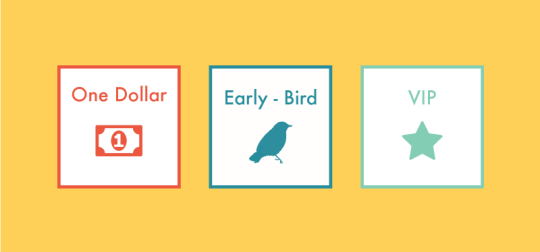In the world of crowdfunding, momentum is a powerful force. Rapid growth in the first couple of days will raise your project’s ranking on Kickstarter and Indiegogo, which will cause you to rank higher on the page for your project category. This could lead to features on blogs or even on the Kickstarter or Indiegogo homepage, which in turn could bring lots of new backers to the table. Not to mention getting you that much closer to fully funding your campaign! In this post, we’ll talk about three ways to optimize your pledge levels to gain momentum for your campaign.
Early Bird Pledge Levels
One way to gain momentum is to offer an early-bird reward level. There are a two major different types of early-bird pledge levels:
- those that offer to ship things earlier
- those that offer items at a bargain price.
If you have the ability to offer an earlier ship-out date to your early-bird backers, that’s a great option because you don’t have to adjust pricing. Then, all of your “later-bird” backers can still get in on the same pricing plan, but just have to wait a little longer. This also makes things easier when it’s time to fulfill orders, as you’ll be able to ship things out in waves.
Otherwise, you can offer the early bird backers a lower price—either by setting that price to exist only for a limited timeframe, or by setting it to run out once a certain number of people have pledged for it. A word to the wise: try to set it up so that you won’t have to create a second “early bird” pledge level later on due to high demand, preserving the symbolic significance of your original early-bird level. This could mean setting a slightly higher-than-expected cap for early-bird pledges.
$1 Pledge Levels
For the purposes of increasing momentum, starting your lowest pledge at $1 is the way to go. This may seem obvious, but if you look through a few project pages on Kickstarter and Indiegogo, you’ll see a lot of pledge levels that start between $2-$5. It doesn’t take a team of psychoanalysts to tell you that $1 is the easiest dollar amount for a human being to spend on a product that doesn’t exist yet. If you’re using BackerKit, you can offer $1 backers the option to buy add-ons later on, which gives indecisive backers a little more time to decide on a pledge after the campaign.
More importantly, though, “new backers per day” is the most heavily weighted factor in Kickstarter’s popularity algorithm. It doesn’t matter what amount each backer has pledged for—the more backers you have, the higher you’ll be listed on Kickstarter’s page for your project’s category. The more buzz you attract, the more backers you attract, which in turn keeps the buzz going! Rinse, Dry, Repeat.
VIP Pledge Levels
Your biggest fans are likely to be your earliest backers. If you offer valuable, high-ticket pledge levels, you can raise money quickly and give your VIP supporters something they’ll be overjoyed to pledge for. With a little extra creativity, you can create interesting VIP rewards that people actually want.
For example, if your project is to crowdfund opening a deli, you could offer to name a sandwich after a backer for the $5,000 pledge level—and don’t be surprised if you find that people are ready and willing to pledge. Just be sure you’re prepared to deliver the VIP rewards when the time comes. You don’t have to go this route, but if you can find a way create online buzz just for having a standout VIP pledge level, you’ll increase your potential momentum, too.
Whether you’re expecting to raise $1,000 or $100,000, the way you structure your pledge levels affects the future of your campaign. Early-bird, VIP, and $1 pledge levels can all peacefully coexist within the same project for the purposes of maximizing your campaign’s momentum.
We hope you’ve found this helpful for your future crowdfunding adventures—stay tuned next week to learn more about optimizing pledge levels to inspire more pledges and to avoid future problems.
As always, feel free to reach out to greetings(at)backerkit(dot)com for more info.
